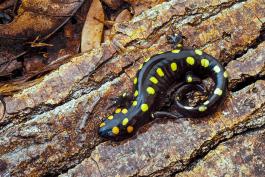Spotted Salamander | Ambystoma maculatum
Status
Locally common
Size
Length: 6–7¾ inches
Distribution
Throughout the southern two-thirds of the state, except the eastern part of the Bootheel. This species may be hard to spot in Missouri. The spotted salamander usually stays hidden under logs or rocks, inside piles of dead leaves, or in burrows of other small animals. And though its name says otherwise, the spotted salamander may not have spots at all, making it even harder to identify.
Life Cycle
Considered early spring breeders, courting salamanders, sometimes numbering in the hundreds, engage in a nuptial dance in shallow, fishless ponds during the first warm rains in February to mid-March. Males deposit a packet of sperm on jellylike stalks, and the females pick it up. The eggs are fertilized as they are laid, within one to two days of courtship. The larvae hatch in a month and live in water until the end of summer.
Foods
They search at night for worms, insects, spiders, and land snails.
Ecosystem Connections
Though spotted salamanders are voracious predators of insects, worms, and slugs, they, along with their eggs and juvenile forms, provide food for many other hungry animals.
Did You Know?
Salamanders offer much for biologists to study. The eggs form a symbiotic relationship with algae. Algae provides oxygen for the embryo and the growing larva supplies nutrients to the algae.


This Issue's Staff
Associate Editor - Bonnie Chasteen
Staff Writer - Larry Archer
Staff Writer - Heather Feeler
Staff Writer - Kristie Hilgedick
Staff Writer - Joe Jerek
Creative Director - Stephanie Thurber
Art Director - Cliff White
Designer - Les Fortenberry
Designer - Marci Porter
Photographer - Noppadol Paothong
Photographer - David Stonner
Circulation - Laura Scheuler






















